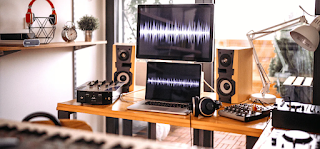Unleashing Audio Excellence: Exploring the World of Sound Cards
Sound cards are the unsung heroes of our digital audio experiences, often overlooked but essential for delivering high-quality sound and immersive audio experiences. Whether you're a music enthusiast, a gamer, or a content creator, understanding the role and capabilities of sound cards can significantly enhance your audio journey. Let's delve into the world of sound cards, exploring their functions, types, benefits, and how they contribute to elevating our audio experiences.
The Role of Sound Cards
At its core, a sound card is a hardware component that processes audio signals, converts digital data into analog sound, and interfaces with speakers, headphones, microphones, and other audio devices. Sound cards play a crucial role in delivering clear, crisp, and immersive audio across various digital platforms, including computers, gaming consoles, and home entertainment systems.
Functions of Sound Cards
Digital-to-Analog Conversion (DAC): One of the primary functions of a sound card is converting digital audio signals (binary data) into analog signals that can be played through speakers or headphones. A high-quality DAC ensures accurate reproduction of audio with minimal distortion.
Analog-to-Digital Conversion (ADC): In addition to playback, sound cards equipped with ADCs allow users to record analog audio signals (e.g., from microphones or musical instruments) and convert them into digital format for processing or storage.
Audio Processing: Advanced sound cards feature built-in audio processors or DSPs (Digital Signal Processors) that enhance audio quality, apply effects (e.g., reverb, equalization), and support surround sound technologies (e.g., Dolby Atmos, DTS:X) for immersive audio experiences.
Connectivity: Sound cards provide various connectivity options, including analog (3.5mm jacks), digital (S/PDIF, HDMI), and USB connections, allowing users to connect a wide range of audio devices and accessories.
Types of Sound Cards
Integrated Sound Cards: Integrated or onboard sound cards are built into motherboards and are commonly found in laptops, desktop computers, and consumer electronics. While they offer basic audio capabilities, they may lack advanced features and audio quality compared to dedicated sound cards.
Dedicated Sound Cards: Dedicated sound cards, also known as discrete sound cards, are separate expansion cards that users can install in their computers for enhanced audio performance. These cards often feature higher-quality DACs, ADCs, audio processing capabilities, and support for advanced audio technologies.
External Sound Cards: External sound cards, also referred to as USB sound cards or audio interfaces, connect to computers or devices via USB ports. They are popular among content creators, musicians, and audiophiles for their portability, versatile connectivity, and improved audio quality compared to onboard solutions.
Benefits of Sound Cards
Enhanced Audio Quality: Sound cards with high-quality DACs and audio processing capabilities deliver clearer, more detailed audio with improved dynamic range and reduced noise/distortion.
Immersive Gaming and Multimedia: Gamers benefit from sound cards that support surround sound technologies, providing spatial audio cues for immersive gaming experiences. Similarly, multimedia enthusiasts enjoy enhanced audio playback for movies, music, and multimedia content.
Recording and Content Creation: Professionals and hobbyists in audio production, podcasting, and content creation rely on sound cards with high-fidelity ADCs and low-latency performance for accurate audio recording and processing.
Customization and Control: Many dedicated sound cards come with software interfaces that allow users to customize audio settings, apply audio effects, adjust equalization, and control various audio parameters for personalized audio experiences.
Choosing the Right Sound Card
When selecting a sound card, consider the following factors:
Audio Quality: Look for sound cards with high-quality DACs (for playback) and ADCs (for recording) to ensure accurate audio reproduction and recording capabilities.
Connectivity: Consider the connectivity options (analog, digital, USB) and compatibility with your audio devices (speakers, headphones, microphones) and computer/system.
Features: Determine the features you need, such as surround sound support, audio processing effects, microphone preamps, MIDI interfaces (for musicians), and software control/interface.
Use Case: Choose a sound card that aligns with your use case, whether it's gaming, multimedia entertainment, content creation, music production, or professional audio applications.
Budget: Consider your budget and prioritize features that are essential for your audio requirements while staying within your budget range.
Conclusion
Sound cards are indispensable components that enhance our audio experiences, whether we're gaming, listening to music, watching movies, or creating content. By understanding their functions, types, benefits, and how to choose the right sound card, users can unlock the full potential of their audio systems and enjoy immersive, high-fidelity sound across various digital platforms. As technology advances, sound cards continue to evolve, offering innovative features and audio solutions that enrich our digital lives and elevate our auditory senses.




Comments
Post a Comment